Pablo Barceló
How Expressive are Knowledge Graph Foundation Models?
Feb 18, 2025Abstract:Knowledge Graph Foundation Models (KGFMs) are at the frontier for deep learning on knowledge graphs (KGs), as they can generalize to completely novel knowledge graphs with different relational vocabularies. Despite their empirical success, our theoretical understanding of KGFMs remains very limited. In this paper, we conduct a rigorous study of the expressive power of KGFMs. Specifically, we show that the expressive power of KGFMs directly depends on the motifs that are used to learn the relation representations. We then observe that the most typical motifs used in the existing literature are binary, as the representations are learned based on how pairs of relations interact, which limits the model's expressiveness. As part of our study, we design more expressive KGFMs using richer motifs, which necessitate learning relation representations based on, e.g., how triples of relations interact with each other. Finally, we empirically validate our theoretical findings, showing that the use of richer motifs results in better performance on a wide range of datasets drawn from different domains.
Explaining k-Nearest Neighbors: Abductive and Counterfactual Explanations
Jan 10, 2025Abstract:Despite the wide use of $k$-Nearest Neighbors as classification models, their explainability properties remain poorly understood from a theoretical perspective. While nearest neighbors classifiers offer interpretability from a "data perspective", in which the classification of an input vector $\bar{x}$ is explained by identifying the vectors $\bar{v}_1, \ldots, \bar{v}_k$ in the training set that determine the classification of $\bar{x}$, we argue that such explanations can be impractical in high-dimensional applications, where each vector has hundreds or thousands of features and it is not clear what their relative importance is. Hence, we focus on understanding nearest neighbor classifications through a "feature perspective", in which the goal is to identify how the values of the features in $\bar{x}$ affect its classification. Concretely, we study abductive explanations such as "minimum sufficient reasons", which correspond to sets of features in $\bar{x}$ that are enough to guarantee its classification, and "counterfactual explanations" based on the minimum distance feature changes one would have to perform in $\bar{x}$ to change its classification. We present a detailed landscape of positive and negative complexity results for counterfactual and abductive explanations, distinguishing between discrete and continuous feature spaces, and considering the impact of the choice of distance function involved. Finally, we show that despite some negative complexity results, Integer Quadratic Programming and SAT solving allow for computing explanations in practice.
Link Prediction with Relational Hypergraphs
Feb 06, 2024Abstract:Link prediction with knowledge graphs has been thoroughly studied in graph machine learning, leading to a rich landscape of graph neural network architectures with successful applications. Nonetheless, it remains challenging to transfer the success of these architectures to link prediction with relational hypergraphs. The presence of relational hyperedges makes link prediction a task between $k$ nodes for varying choices of $k$, which is substantially harder than link prediction with knowledge graphs, where every relation is binary ($k=2$). In this paper, we propose two frameworks for link prediction with relational hypergraphs and conduct a thorough analysis of the expressive power of the resulting model architectures via corresponding relational Weisfeiler-Leman algorithms, and also via some natural logical formalisms. Through extensive empirical analysis, we validate the power of the proposed model architectures on various relational hypergraph benchmarks. The resulting model architectures substantially outperform every baseline for inductive link prediction, and lead to state-of-the-art results for transductive link prediction. Our study therefore unlocks applications of graph neural networks to fully relational structures.
A neuro-symbolic framework for answering conjunctive queries
Oct 06, 2023Abstract:The problem of answering logical queries over incomplete knowledge graphs is receiving significant attention in the machine learning community. Neuro-symbolic models are a promising recent approach, showing good performance and allowing for good interpretability properties. These models rely on trained architectures to execute atomic queries, combining them with modules that simulate the symbolic operators in queries. Unfortunately, most neuro-symbolic query processors are limited to the so-called tree-like logical queries that admit a bottom-up execution, where the leaves are constant values or anchors, and the root is the target variable. Tree-like queries, while expressive, fail short to express properties in knowledge graphs that are important in practice, such as the existence of multiple edges between entities or the presence of triangles. We propose a framework for answering arbitrary conjunctive queries over incomplete knowledge graphs. The main idea of our method is to approximate a cyclic query by an infinite family of tree-like queries, and then leverage existing models for the latter. Our approximations achieve strong guarantees: they are complete, i.e. there are no false negatives, and optimal, i.e. they provide the best possible approximation using tree-like queries. Our method requires the approximations to be tree-like queries where the leaves are anchors or existentially quantified variables. Hence, we also show how some of the existing neuro-symbolic models can handle these queries, which is of independent interest. Experiments show that our approximation strategy achieves competitive results, and that including queries with existentially quantified variables tends to improve the general performance of these models, both on tree-like queries and on our approximation strategy.
On the Power of the Weisfeiler-Leman Test for Graph Motif Parameters
Oct 02, 2023Abstract:Seminal research in the field of graph neural networks (GNNs) has revealed a direct correspondence between the expressive capabilities of GNNs and the $k$-dimensional Weisfeiler-Leman ($k$WL) test, a widely-recognized method for verifying graph isomorphism. This connection has reignited interest in comprehending the specific graph properties effectively distinguishable by the $k$WL test. A central focus of research in this field revolves around determining the least dimensionality $k$, for which $k$WL can discern graphs with different number of occurrences of a pattern graph $P$. We refer to such a least $k$ as the WL-dimension of this pattern counting problem. This inquiry traditionally delves into two distinct counting problems related to patterns: subgraph counting and induced subgraph counting. Intriguingly, despite their initial appearance as separate challenges with seemingly divergent approaches, both of these problems are interconnected components of a more comprehensive problem: "graph motif parameters". In this paper, we provide a precise characterization of the WL-dimension of labeled graph motif parameters. As specific instances of this result, we obtain characterizations of the WL-dimension of the subgraph counting and induced subgraph counting problem for every labeled pattern $P$. We additionally demonstrate that in cases where the $k$WL test distinguishes between graphs with varying occurrences of a pattern $P$, the exact number of occurrences of $P$ can be computed uniformly using only local information of the last layer of a corresponding GNN. We finally delve into the challenge of recognizing the WL-dimension of various graph parameters. We give a polynomial time algorithm for determining the WL-dimension of the subgraph counting problem for given pattern $P$, answering an open question from previous work.
Three iterations of $$-WL test distinguish non isometric clouds of $d$-dimensional points
Mar 28, 2023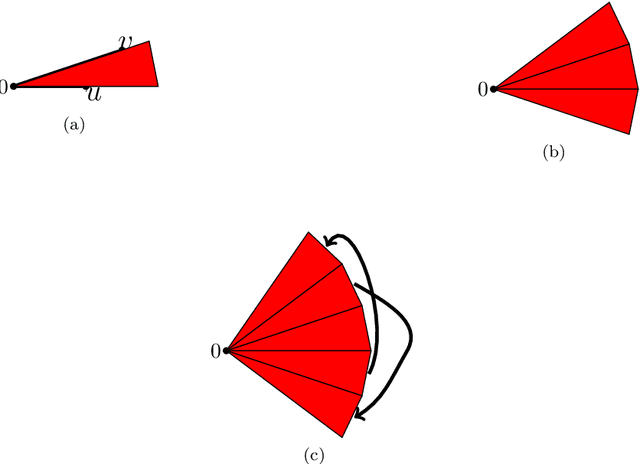
Abstract:The Weisfeiler--Lehman (WL) test is a fundamental iterative algorithm for checking isomorphism of graphs. It has also been observed that it underlies the design of several graph neural network architectures, whose capabilities and performance can be understood in terms of the expressive power of this test. Motivated by recent developments in machine learning applications to datasets involving three-dimensional objects, we study when the WL test is {\em complete} for clouds of euclidean points represented by complete distance graphs, i.e., when it can distinguish, up to isometry, any arbitrary such cloud. Our main result states that the $(d-1)$-dimensional WL test is complete for point clouds in $d$-dimensional Euclidean space, for any $d\ge 2$, and that only three iterations of the test suffice. Our result is tight for $d = 2, 3$. We also observe that the $d$-dimensional WL test only requires one iteration to achieve completeness.
A Theory of Link Prediction via Relational Weisfeiler-Leman
Feb 04, 2023



Abstract:Graph neural networks are prominent models for representation learning over graph-structured data. While the capabilities and limitations of these models are well-understood for simple graphs, our understanding remains highly incomplete in the context of knowledge graphs. The goal of this work is to provide a systematic understanding of the landscape of graph neural networks for knowledge graphs pertaining the prominent task of link prediction. Our analysis entails a unifying perspective on seemingly unrelated models, and unlocks a series of other models. The expressive power of various models is characterized via a corresponding relational Weisfeiler-Leman algorithm with different initialization regimes. This analysis is extended to provide a precise logical characterization of the class of functions captured by a class of graph neural networks. Our theoretical findings explain the benefits of some widely employed practical design choices, which are validated empirically.
No Agreement Without Loss: Learning and Social Choice in Peer Review
Nov 03, 2022Abstract:In peer review systems, reviewers are often asked to evaluate various features of submissions, such as technical quality or novelty. A score is given to each of the predefined features and based on these the reviewer has to provide an overall quantitative recommendation. However, reviewers differ in how much they value different features. It may be assumed that each reviewer has her own mapping from a set of criteria scores (score vectors) to a recommendation, and that different reviewers have different mappings in mind. Recently, Noothigattu, Shah and Procaccia introduced a novel framework for obtaining an aggregated mapping by means of Empirical Risk Minimization based on $L(p,q)$ loss functions, and studied its axiomatic properties in the sense of social choice theory. We provide a body of new results about this framework. On the one hand we study a trade-off between strategy-proofness and the ability of the method to properly capture agreements of the majority of reviewers. On the other hand, we show that dropping a certain unrealistic assumption makes the previously reported results to be no longer valid. Moreover, in the general case, strategy-proofness fails dramatically in the sense that a reviewer is able to make significant changes to the solution in her favor by arbitrarily small changes to their true beliefs. In particular, no approximate version of strategy-proofness is possible in this general setting since the method is not even continuous w.r.t. the data. Finally we propose a modified aggregation algorithm which is continuous and show that it has good axiomatic properties.
Foundations of Symbolic Languages for Model Interpretability
Oct 05, 2021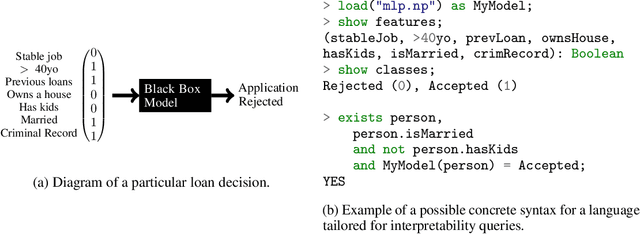
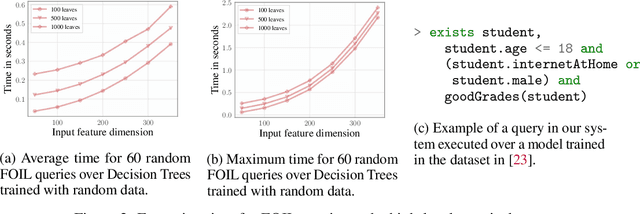
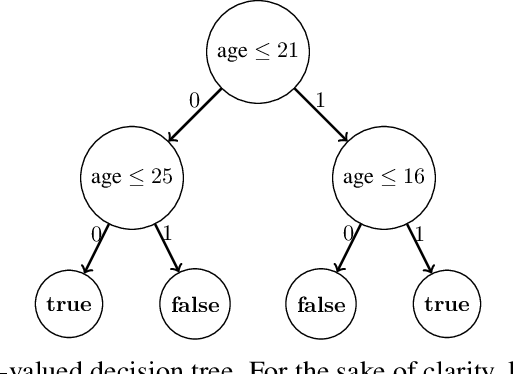
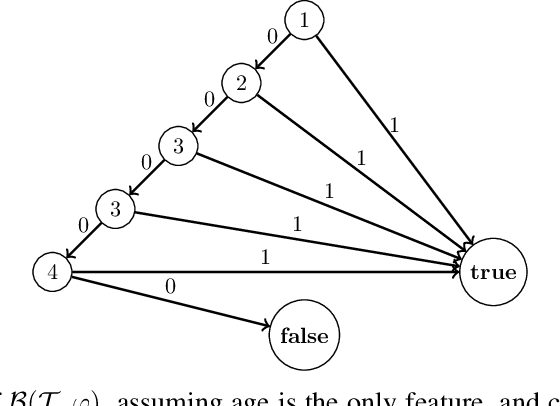
Abstract:Several queries and scores have recently been proposed to explain individual predictions over ML models. Given the need for flexible, reliable, and easy-to-apply interpretability methods for ML models, we foresee the need for developing declarative languages to naturally specify different explainability queries. We do this in a principled way by rooting such a language in a logic, called FOIL, that allows for expressing many simple but important explainability queries, and might serve as a core for more expressive interpretability languages. We study the computational complexity of FOIL queries over two classes of ML models often deemed to be easily interpretable: decision trees and OBDDs. Since the number of possible inputs for an ML model is exponential in its dimension, the tractability of the FOIL evaluation problem is delicate but can be achieved by either restricting the structure of the models or the fragment of FOIL being evaluated. We also present a prototype implementation of FOIL wrapped in a high-level declarative language and perform experiments showing that such a language can be used in practice.
Graph Neural Networks with Local Graph Parameters
Jun 12, 2021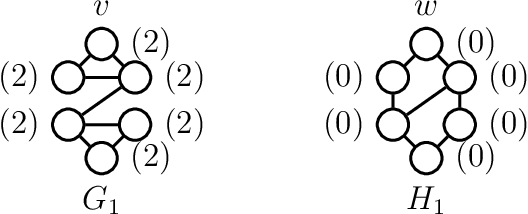

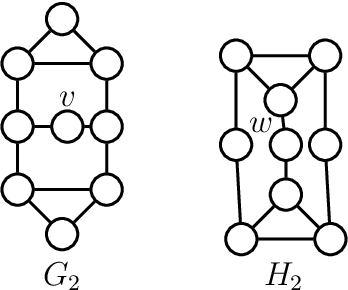
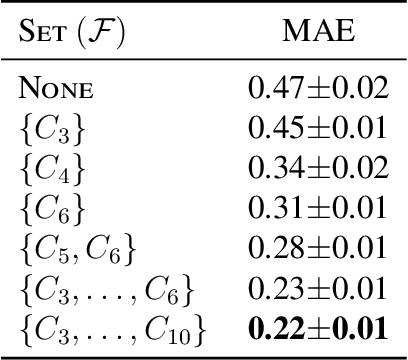
Abstract:Various recent proposals increase the distinguishing power of Graph Neural Networks GNNs by propagating features between $k$-tuples of vertices. The distinguishing power of these "higher-order'' GNNs is known to be bounded by the $k$-dimensional Weisfeiler-Leman (WL) test, yet their $\mathcal O(n^k)$ memory requirements limit their applicability. Other proposals infuse GNNs with local higher-order graph structural information from the start, hereby inheriting the desirable $\mathcal O(n)$ memory requirement from GNNs at the cost of a one-time, possibly non-linear, preprocessing step. We propose local graph parameter enabled GNNs as a framework for studying the latter kind of approaches and precisely characterize their distinguishing power, in terms of a variant of the WL test, and in terms of the graph structural properties that they can take into account. Local graph parameters can be added to any GNN architecture, and are cheap to compute. In terms of expressive power, our proposal lies in the middle of GNNs and their higher-order counterparts. Further, we propose several techniques to aide in choosing the right local graph parameters. Our results connect GNNs with deep results in finite model theory and finite variable logics. Our experimental evaluation shows that adding local graph parameters often has a positive effect for a variety of GNNs, datasets and graph learning tasks.
 Add to Chrome
Add to Chrome Add to Firefox
Add to Firefox Add to Edge
Add to Edge